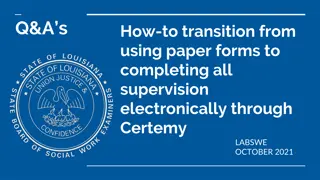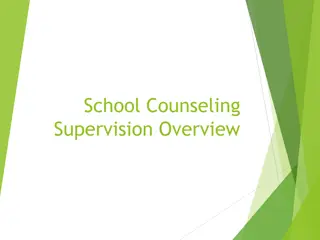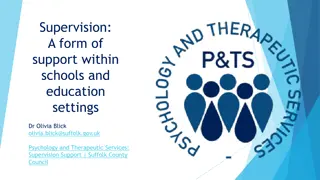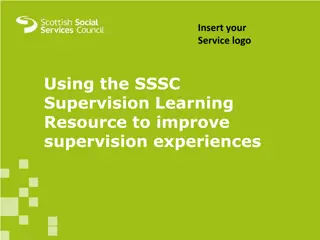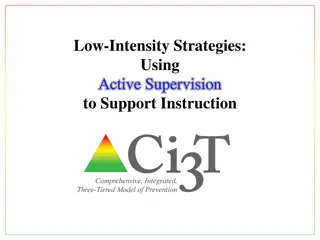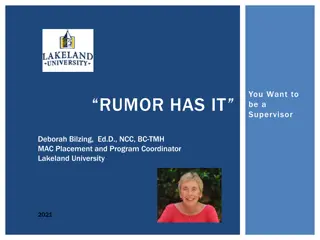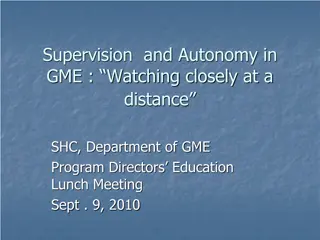Supervision in Rocky Mountain Communities
Dive deep into the requirements and responsibilities of becoming a Designated Qualified Clinical Supervisor (DQCS) in Wyoming. Understand the importance of meeting ethical standards outlined by the ACA Code of Ethics and the supervisor-supervisee relationship dynamics.
Download Presentation

Please find below an Image/Link to download the presentation.
The content on the website is provided AS IS for your information and personal use only. It may not be sold, licensed, or shared on other websites without obtaining consent from the author.If you encounter any issues during the download, it is possible that the publisher has removed the file from their server.
You are allowed to download the files provided on this website for personal or commercial use, subject to the condition that they are used lawfully. All files are the property of their respective owners.
The content on the website is provided AS IS for your information and personal use only. It may not be sold, licensed, or shared on other websites without obtaining consent from the author.
E N D
Presentation Transcript
A Deep Dive into Supervision in Rocky Mountain Communities AMANDA DEDIEGO, PHD, NCC ANDREW SOUTHERLAND, MS, PPC ANDREA MCGRATH, MA, LPC LAY-NAH BLUE MORRIS-HOWE, PHD, LPC
Designated Qualified Clinical Supervisor (DQCS) Requirements Licensed for independent practice for a minimum of two years prior to becoming a supervisor. (To meet the two years, your independent license can be from another state.) Have 4 years of post-graduate professional experience in your discipline prior to providing supervision. Not have any disciplinary action from the Board. (Exceptions can be granted from this requirement by the Board.)
Designated Qualified Clinical Supervisor (DQCS) Responsibilities Verify your supervisee is performing within their training and experience and within the rules of the Wyoming Mental Health Professions Licensing Board. Keep records. This includes hours of clinical experience, direct client hours and your supervision hours with supervisee which follow the rules. (Agreements must be approved by the Board, please keep a copy of the approved agreement that is emailed to you after approval.) Report hours and evaluation of supervisees work with you by using a Verification and Evaluation of Supervised Experience Form. Please submit form as soon as possible after supervision has been completed. Follow all other requirements on the supervision agreement and rules.
Supervision and ACA Code of Ethics F.1.a Supervisors meet regularly with supervisees to ensure client welfare and supervisee development F.2.b Supervisors address culture and diversity in relationship with supervisee F.3.a Supervisors consider boundaries with supervisees and determine risk/benefit to extending relationships to avoid impairment of judgment F.3.b Sexual relationships with a supervisee is prohibited F.3.d Supervisors should not supervise family or friends F.6.c Supervisors should not provide counseling services for the supervisee
Responsibilities under ACA Code of Ethics F.1.a Supervisors meet regularly with supervisees to ensure client welfare and supervisee development F.2.b Supervisors address culture and diversity in relationship with supervisee F.3.a Supervisors consider boundaries with supervisees and determine risk/benefit to extending relationships to avoid impairment of judgment F.3.b Sexual relationships with a supervisee is prohibited F.3.d Supervisors should not supervise family or friends F.6.c Supervisors should not provide counseling services for the supervisee
Responsibilities under ACA Code of Ethics Supervisor Supervisee F.4.a Informed Consent F.5.a Follow and understand ACA Code of Ethics F.4.b Emergency and absence plan F.5.b Monitor for impairment and seek support F.4.d Right to terminate relationship F.6.b Gatekeeping F.5.c Explain nature of supervision to clients
Utilizing Theory in Supervision Strong supervision is underscored by a theoretical foundation Many models of supervision theory, including developmental models, counseling theory models, and process models
Person- Centered Supervision Assumes that supervisee has the personal resources to effectively develop as a counselor Supervisor serves as a collaborator with the supervisee, rather than the expert As collaborator, the role of the supervisor is to provide the environment in which the supervisee can be open and engaged in one s own experience in working with clients Effective learning and growth in supervision occurs as a result of the supervisor- supervisee relationship
Person- Centered Supervision Characteristics and Principles of Person-Centered Supervision: Trust between supervisor and supervisee is foundational Empathy is the core principle-- step in the shoes Supervisors simultaneously act as a teacher, coach, mentor, and consultant Supervisor and Supervisee treat one another with warmth, sensitivity, respect, and trust Supervisee feels safe to explore oneself personally and professionally, as supervisor has created this safe relationship
Reflective Aim: Growing supervisees into self-supervisors. Developmental Model of Supervision Method: Inviting reflection on clinical experiences to promote a shift from novice to expert Areas of Focus: Skills/Strategies, Personhood issues, and Conceptualization Trigger Event > Reaction > Reevaluation > Growth
Reflective Developmental Model of Supervision Expert Novice Feedback-oriented supervision: Supervisor as a teacher Reflectivity-oriented supervision: Supervisor as consultant Active Passive
Developmental Characteristics of Supervisee Supervision Strategies Stage Level 1 High motivation, high level of anxiety, lack High level of structure, use of of self-awareness, high dependence on exemplars, instruction on skills, Integrative Developmental Model of Supervision supervisor training to raise awareness, strengths- based approach Level 2 Conflict between autonomy and Less structure, provides less direct dependence on supervisor, increased instruction, focus on facilitation, offers self-awareness, less imitation, seeks conceptual viewpoints, parallel independence process, process counselor reactions Level 3 Developing counseling identity, Structure comes from supervisee, demonstrates insight, integration of own supervisor acts as consultant, ideals and ethical standards, empathy for challenges to avoid stagnation, use of client grows, self-acceptance of strengths confrontation and limitations
Discrimination Model of Supervision Main Tenets Supervision is seen as both an educational and relational process. Supervisors take on a number of distinct roles in supervision based on supervisee needs, experiences, and developmental factors. Supervisors must assess supervisees needs among three foci and select a corresponding supervisor role to meet these needs.
Discrimination Model of Supervision Supervision has three main foci/purposes Intervention Conceptualization Personalization Observable behavior that supervisees display in session, including skills, techniques, and clinical interventions Supervisee self-awareness and ability to adapt his or her own personal style of counseling while maintaining awareness of personal issues and countertransference Cognitive process, including supervisee s ability to recognize the client s themes and patterns Supervisee s level of understanding of what is taking place in session
Discrimination Model of Supervision Supervisors take on three main roles in supervision Teacher Counselor Consultant Used when the supervisee needs instruction or direct feedback Used to increase supervisee reflectivity Used when supervisee is able to think and act independently Supervisor encourages supervisee to process experiences and responses to clients Supervisor provides information and resources Supervisor takes a collaborative role to encourage supervisee autonomy and promote independent thinking
ACES Best Practices in Supervision
Guideline 1: Initiating Supervision Informed Consent Clear Parameters Discuss Supervision Process
Guideline 2: Goal-setting Co-develop Specific Goals Goals that directly benefit the therapeutic alliance Intentionally addressing and evaluating goals
Guideline 3: Giving Feedback Regular and Ongoing Feedback Direct Feedback Attend to Multiple Sources of Feedback
Guideline 4: Conducting Supervision Supervisor adheres to appropriate professional standard (accreditation, licensure, certification) Provides a climate that is safe, supportive, and structured Uses a variety of supervisory interventions to meet supervisee needs If group or triadic supervision formats are used, this is decided considering multiple reasons--time efficiency being the least influential Technology is only used in ways that enhance the supervisory process and development of supervisee Supervisor engages in ongoing evaluation of the course of supervision
Guideline 5: The Supervisory Relationship The supervisory relationship is key to the effectiveness of supervision as well as the growth and development of the supervisee Supervisors intentionally work together with the supervisee to create a productive supervisory relationship and working alliance Ethical and cultural concerns that may impact the supervisory relationship are addressed by the supervisor
Guideline 6: Diversity and Advocacy Considerations Supervisors must recognize that ALL supervision is multicultural supervision and infuse multicultural considerations into the supervision approach Issues of diversity, culture, power, and privilege are introduced by the supervisor Supervisors must engage in their own ongoing assessment Supervisors encourage their supervisees to infuse diversity and advocacy considerations in their work with clients Case conceptualization, diagnosis, and treatment planning should all include considerations of culture, power, and privilege Supervisors encourage supervisees to seek opportunities to work with a diverse client population
Guideline 7: Ethical Considerations Ensuring supervisee and supervisor abides by the ACA code of ethics Supervisor monitors their own level of competence and acts accordingly Supervisor prioritizes the welfare of clients Avoiding multiple relationships with supervisees Supervisor provides evaluation and assessment of supervisee skills
Guideline 8: Documentation Supervisor maintains documentation Supervision contract, case notes, and evaluations Case notes require informed consent, content, method of review, goals developed, and recommendations. As needed, remediation Must keep documentation secure and separate from client files Maintains documentation accoding to agency or organization standards
Guideline 9: Evaluation Evaluation is fundamental to supervision Emphasize both strengths and growth areas Supervisee must have opportunity to offer feedback on supervisoryt process Observation is key to evaluating supervisee performance Evaluation plan is clearly communicated to supervisee Supervisor encourages supervisee self-evaluation Remediation occurrs as necessary
Guideline 10: Supervision Format Provides supervision in various formats in accordance with supervisee needs and regulations (individual, triadic) Chooses supervision structure and format to benefit supervisee, not supervisor convenience Thinks about pairing for triadic intentionally
Wyoming Rules Wyoming Rules: Individual, triadic face-to-face clinical supervision and/or individual distance clinical supervision by a DQCS shall be provided monthly at a ratio of at least one (1) hour for every twenty (20) hours of direct clinical provision of services defined in this act. Not provide supervision to more than (5) supervisees at one time, unless granted an exception in writing from the Board; Allow (1)Individual Face-to-Face Clinical Supervision, (2) Triadic Face-to-Face Clinical Supervision, (3) Individual Distance Clinical Supervision.
Guideline 11: Supervisor Supervisor should be Competent and trained in supervision Experienced practitioner with knowledge of theory and technique Ethical in practice Knowledgeable about requirements Considers advocacy and culture in supervision Maintains supervision records Understands role as evaluator and gatekeeper Engages in reflection and self-awareness
Guideline 12: Supervision Training Supervisors should receive training in supervision theory and techniques Should have ongoing support and training Models of supervision Counselor development Format of supervision Assessment and feedback Ethical and legal issues
Consultation and Practice Issues



![[PDF READ ONLINE] Mountain Claiming (BIG-Secrets of Mountain Men Book 3)](/thumb/42287/pdf-read-online-mountain-claiming-big-secrets-of-mountain-men-book-3.jpg)

